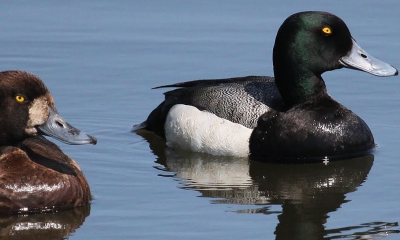
Scaup
Scaup are diving ducks that often congregate in large “rafts” of ducks on the water.

Types of Scaup

Features: Greater scaup are almost the size of redheads. In hand, they are easily distinguishable from lesser scaup by size and by the white wing stripe extending beyond the secondaries into the primaries. In the field, the two species can be difficult to separate. Drakes are black on both ends and white in the middle. Although not extremely reliable, in good light, generally the black head of drake grater scaup have a green sheen, while the head of a drake lesser scaup have a purple sheen. Hens are dark brown with a white mask around the base of the bill.
Habitat: They are an abundant migrant and winter visitor in the Columbia River estuary and common to abundant on coastal bays and lower river segments. Greater scaup form large flocks, sometimes mingling with lesser scaup in fall and winter.
Techniques: Most hunters use a boat to target scaup in the lower Columbia River and open water estuaries. A favorite technique is to set large spreads of scaup decoys using long line systems. Hunters have mixed opinions about scaup as table fare.

Features: Similar to the greater scaup in appearance and habits, but smaller and lacking the white on the primaries. In the field, however, the black-and-white drakes and brown hens are very similar to greater scaups.
Habitat: In general, the lesser scaup is more likely to be found in interior or freshwater habitats while the greater scaup is more a coastal bird.
Techniques: Scaup are rafting birds attracted to large spreads of scaup decoys. Popular hunting destinations include coastal estuaries and lakes, where most hunters hunt from a boat. However, in the marshes of eastern Oregon, there can be good hunting on foot.

